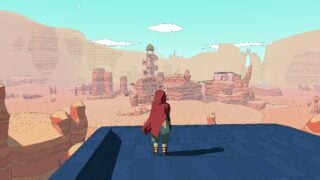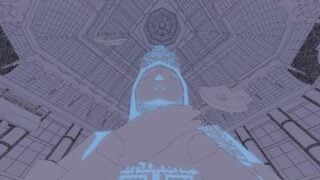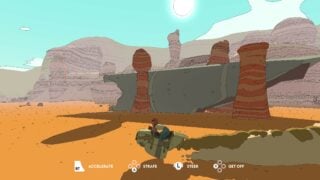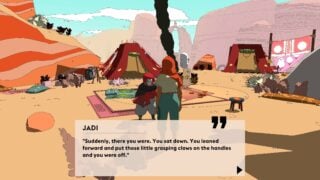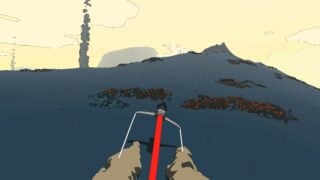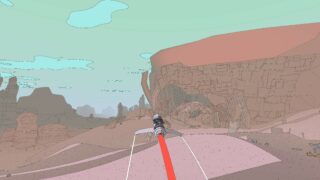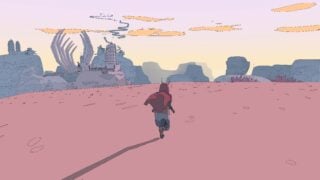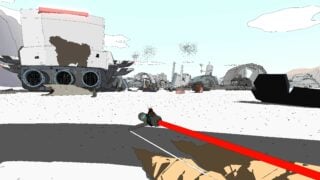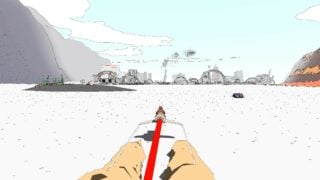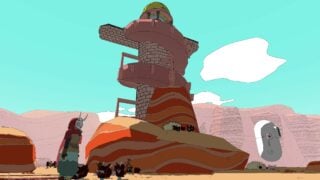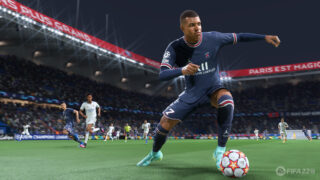Review: Sable journeys from relaxation to frustration, and back again
A visually stunning adventure undermined by performance issues and dull quest design.
- Creative director
- Gregorios Kythreotis
- Key Credits
- Daniel Fineberg (Technical director)

Sable is a game where the gameplay feels at odds with the atmosphere it’s trying to create.
While there are great moments of quiet reflection, stunning scenery and a colour palette that it’s hard to overpraise, Sable is let down by a central gameplay mechanic that disrupts any zen you might achieve. A confusing quest structure and performance issues also plague a game that’s an unending treat to look at in screenshots, but when the action begins, so do the problems.
Nothing ruins my enjoyment of Sable more than Sable itself. It presents an incredible desert for you to explore, as you set off from your home camp on your coming of age journey, but while the destinations you’ll reach are stunning, detailed and often crammed with great writing, the journey to get there is laborious. You’ll spend the majority of your time on your glider, a floating bike that expels a jet of brilliant red flames as you speed through the dunes.
The wide gaps between places of interest should be a time to reflect, a time to enjoy the atmosphere, and a time to relax. However, due to the bike almost constantly juddering, looking at it for an extended period of time started to hurt our eyes. Far from the smooth, graceful glides that you’d imagine, it’s like you’re trying to drive over gravel in a shopping trolley with three wheels.
What makes this even more disappointing is occasionally, for fleeting seconds you’ll start to glide smoothly, despite no change to terrain you’re actually traversing. In these moments you get to see the game we wish Sable was, a low-key, relaxing journey through the desert. Instead what you end up with is an attempt to meditate while construction work is being done outside your window.
You’re tasked with collecting badges from characters across the world, these badges can then be exchanged for masks, a key part in your journey known as The Gliding. Once you leave your home camp, you’re given very little direction in terms of where to go apart from a small outpost not far from home. As you head towards it, you’ll notice that the world of Sable is littered with discarded machinery, and abandoned husks of the enormous spaceships, their crew long dead.
It’s hard not to be reminded of Rey scavenging through the wreckage of a crashed Star Destroyer in Star Wars Episode VII: The Force Awakens. You even slide down the sand dunes in the same way. This element of exploration, and especially Sable’s ability to climb on basically any surface, make for some moments of platforming and light puzzle solving, though the reward is rarely beyond a basic collectible.
The quests themselves are rather simplistic, you’re often just gliding to one place to talk to someone, and then gliding to another. However, I did enjoy almost all of the conversions in the game. The writing is charming, witty and heartfelt. It doesn’t take itself too seriously, and your character’s internal thoughts, which are shown as text in a different font, give great insight into your journey.
The quest structure does get rather repetitive, especially when some quests give you zero direction as to what to do next. Sable’s compass system is clever in the sense that it’s displayed in a ring around Sable itself, but it goes to waste when so many quests don’t give you quest markers in order to actually use it.
“We repeatedly found myself with very little of interest to actually do in Sable. We’d have loved to explore every inch of the vast map, but my complete discomfort while actually gliding around made the prospect of finding a new ship or a new settlement a tedious one.”
Visually the game is a mix of single line drawings and an absolutely stunning colour palette that makes it an absolute joy to look at. In the middle of the day, the colours might be bright, primary reds and greens, but as the sunsets, the colours all slowly move down the gradient, and you’ll find yourself in a sea of peaceful violets and blues. The game’s willingness to let the colour be so free flowing and overwhelming is one of its greatest strengths.
Sable’s soundtrack is another highlight, with indie-rock band Japanese Breakfast providing several tracks heard throughout the game. The first instance of this, when Sable is gliding away from her home for the first time, ready to explore the larger world around her is a genuinely quite moving sequence.
We repeatedly found ourselves with very little of interest to actually do in Sable. We’d have loved to explore every inch of the vast map, but my complete discomfort while actually gliding around made the prospect of finding a new ship or a new settlement a tedious one.

Our favourite moments came when we’d wandered into an unknown region of the map, and found ourselves below the hulking shell of a ship. We spent the next 40 minutes slowly climbing up it, managing the temperamental stamina system, and slowly progressed up the structure. It wasn’t the most difficult platforming puzzle ever, nor was it the most rewarding, but it was relaxing, and the surrounding environment was stunning.
The game we wish Sable was is so within our grasp, that it’s disappointing for something so core to the game, in this case the gliding, to mar what had the potential to be a truly wonderful experience. There’s nothing wrong with a game about doing simple things, and enjoying a relaxing journey in between, but in Sable, we could never relax.
It’s like trying to get comfortable in bed, but you can’t stop tossing and turning. Then you look at your phone, and it’s 4 in the morning.
There’s nothing wrong with a game about doing simple things, and enjoying a relaxing journey in between, but in Sable, we could never relax.
- Visual masterpiece
- Wonderful soundtrack
- Charming writing
- Constant visual judder while gliding
- Dull quest structure
- Often useless compass.






